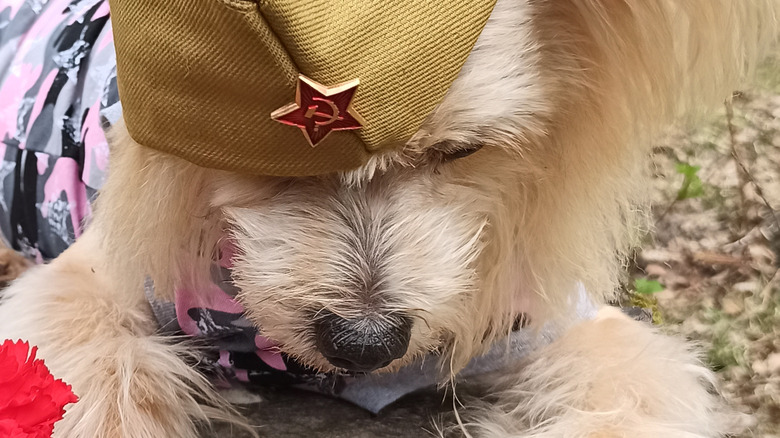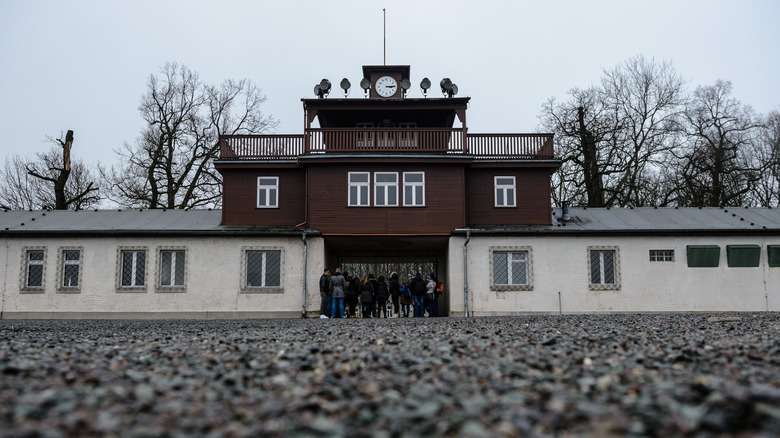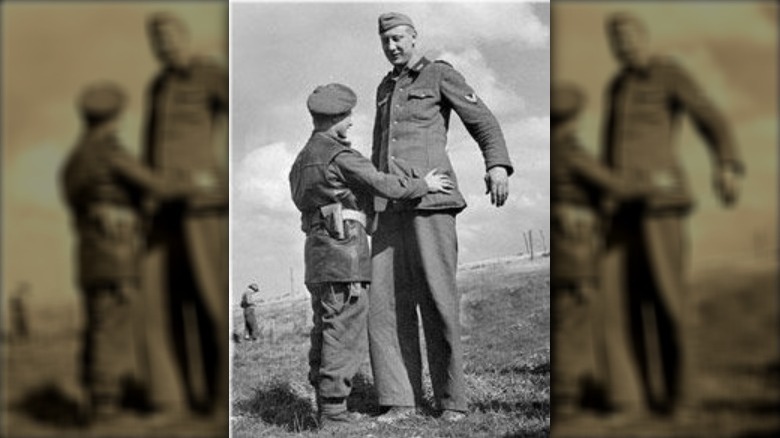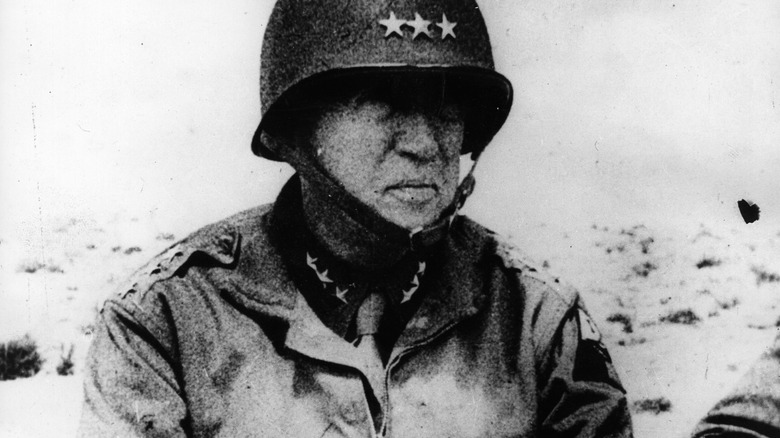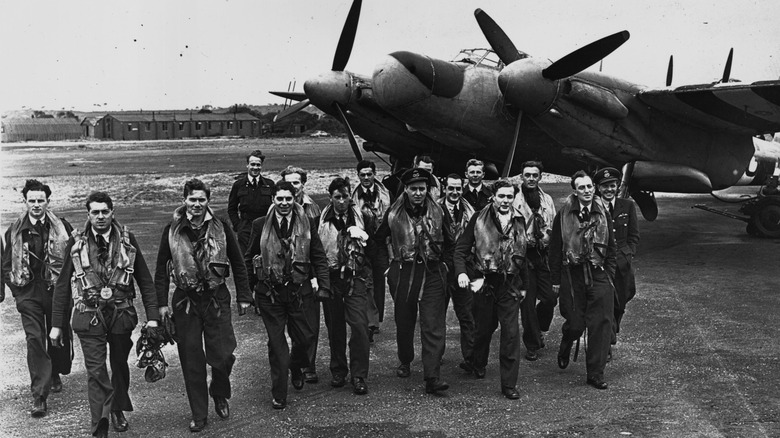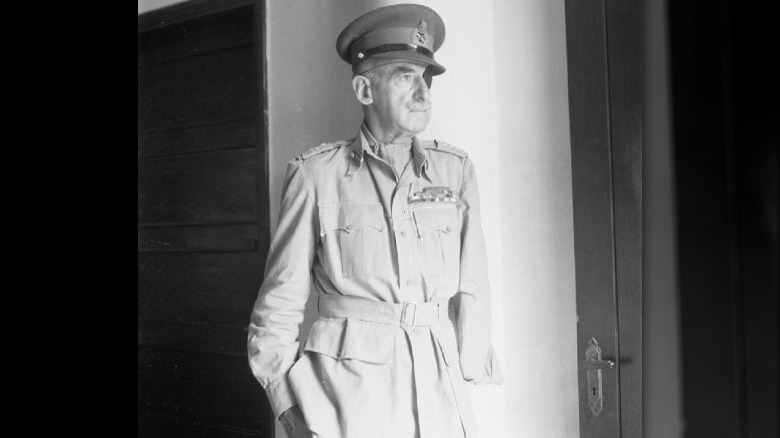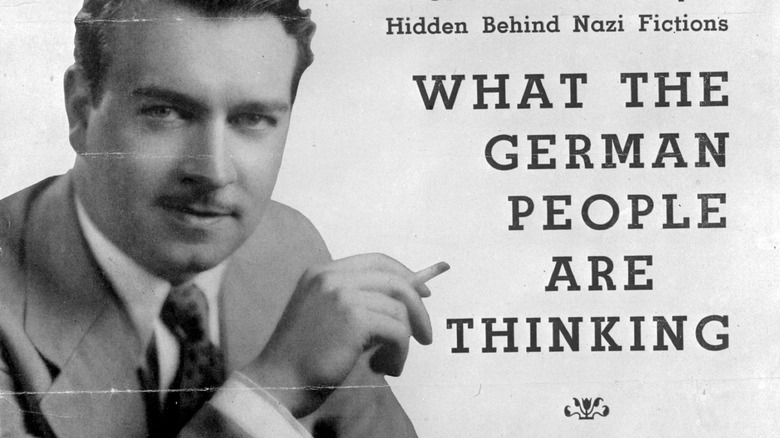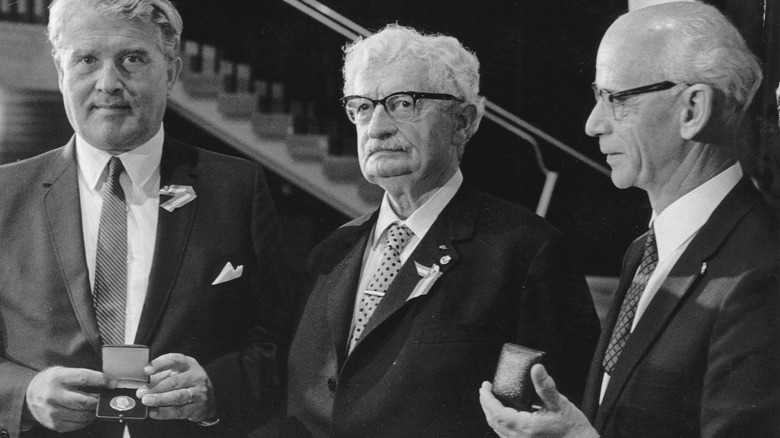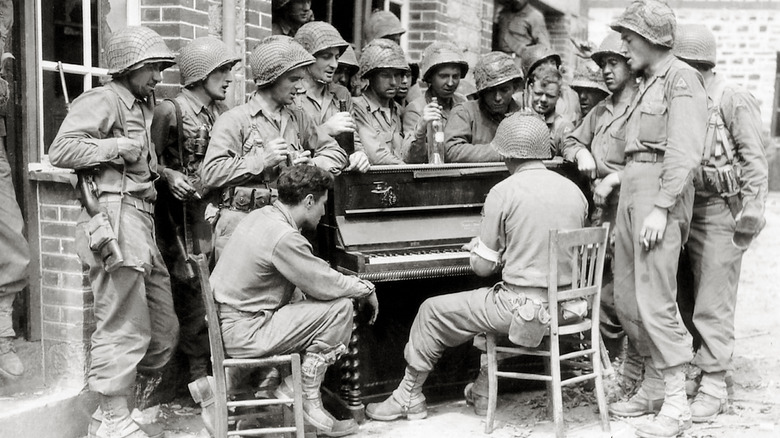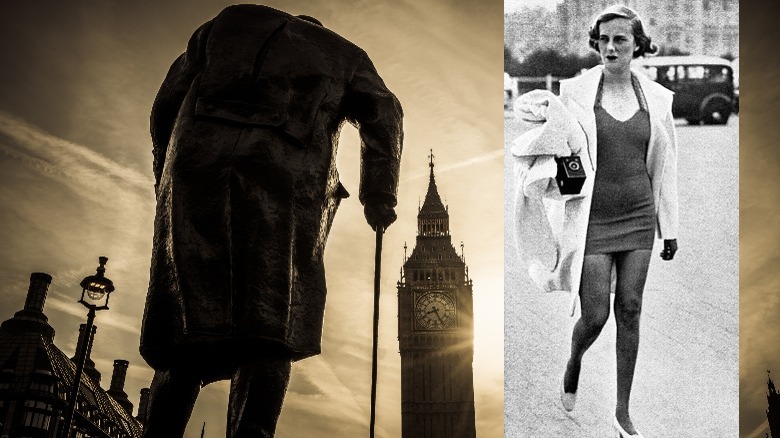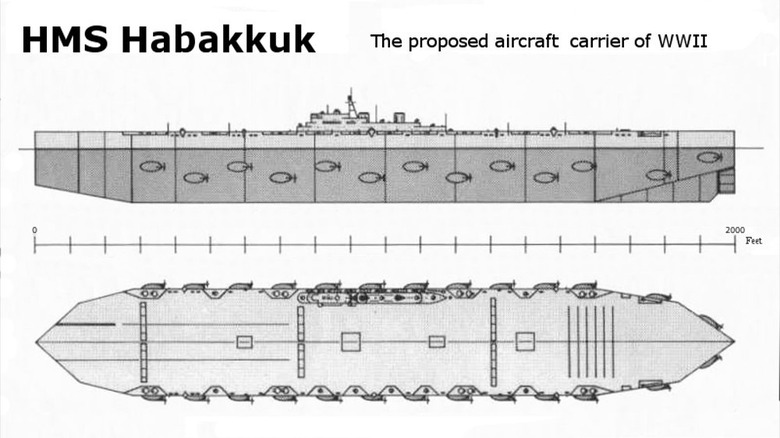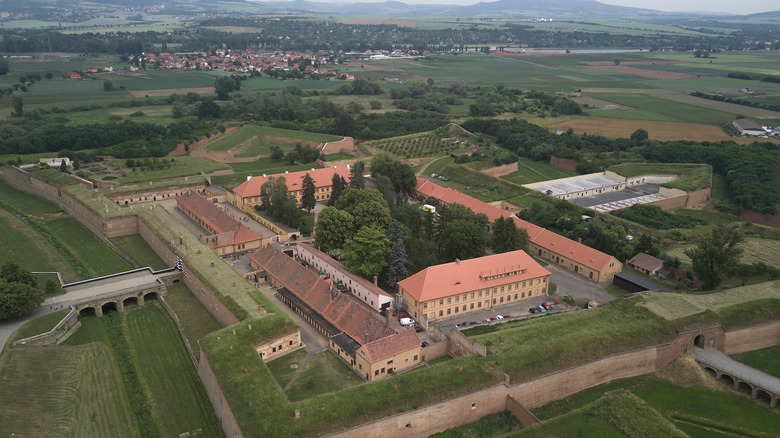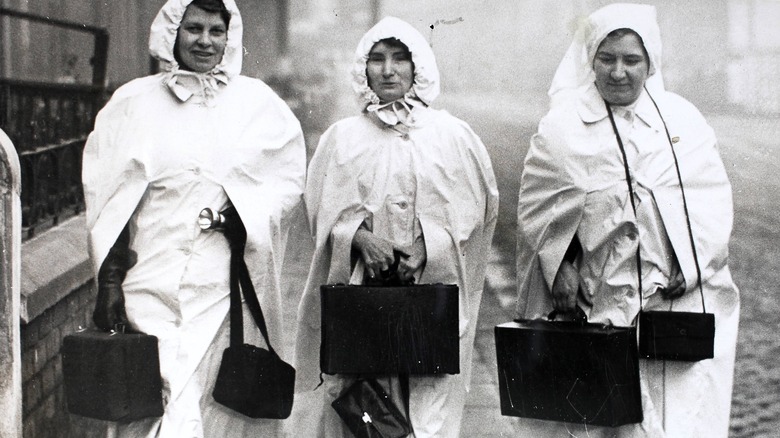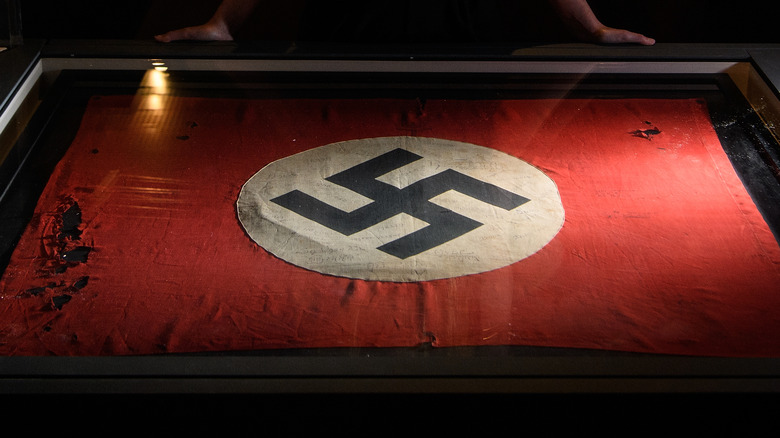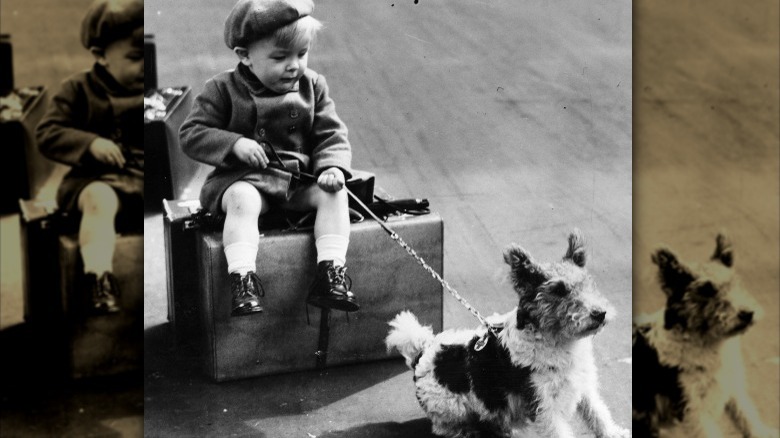World War II Stories That Sound Fake, But Aren't
World War II is full of shockingly bloody and awful things, shining a big ol' spotlight on the worst side of humanity and — in many cases — also, the best. Just as it's full of hate, bigotry, racism, and just plain murder, it's also full of stories of people who were willing to make the ultimate sacrifice for those they had never even met. But it's also full of things that make you go, "Wait, what? No, that's not real ... is it?"
What kind of stories are those? How about the one about the serial killer that set up in occupied France, using his street cred as a doctor to promise those fleeing the Nazi regime a helping hand... only to turn around and murder them? It sounds like the plot of a far-fetched television series, but it's absolutely real. His name was Marcel Petiot, but he earned himself the nickname Dr. Satan. His story was forgotten for a long time, until history professor David King did a deep dive into wartime records to uncover the truth about this opportunistic killer, who posed as a member of the Resistance and dismembered as many as 150 bodies (via Reuters). Petiot eventually got his comeuppance: His crimes were discovered after his house burnt down, and he couldn't explain the remains of the scores of victims that were found in the rubble. Perhaps unsurprisingly, he was executed.
Bizarre? Yes. Absolutely true? Also yes — just like these other weird tales from WWII.
Buchenwald had a zoo
Concentration camps were singularly terrible places, and there were a lot of them — around 44,000 of varying types and sizes, according to the United States Holocaust Memorial Museum. But for this, let's look at Buchenwald.
Adolf Hitler was famously fond of his dog Blondi, but it turns out, that's not the only time animals got the A-OK from high-ranking Nazi officials. Buchenwald, says DW, actually contained a small zoo on the grounds — a zoo, they say, that wasn't too far from the crematorium.
At the time the zoo opened in 1938, the camp was under the control of Karl Koch and his wife, Ilse. (She, says History, was the one who liked to select the prisoners who had what she deemed the most "artistic" tattoos, have them killed, skinned, and made into things like lampshades and gloves.) The zoo was, of course, both funded by assets seized from the prisoners, and off-limits to all those save the ones that were tasked with taking care of the animals, which included monkeys, birds, and fish. The idea was that it was meant to provide "diversion and entertainment" for guards who wanted to go there on their breaks. Koch liked to go there, too, because there was also a bear pit and he was particularly fond of throwing people in and watching the carnage.
The biggest Nazi surrendered to the smallest Allied soldier
In 2015, The Telegraph reported on the presentation of the Legion d'honneur medal to 3,000 soldiers who had helped liberate France from Nazi occupation. Among them was the British Bob Roberts, who had an incredible story of cheating death on multiple occasions, including the time when a sniper's shot just grazed his scalp instead of killing him instantly.
Roberts was a diminutive figure. Standing just 5-foot-3-inches, he would have been exempt from service in World War II, until, that is, the BBC says the British Army put together so-called "Bantam battalions" specifically for shorter men. (Height requirements were ultimately lowered as the war dragged on.) And it's his height that made it particularly hilarious that he was sent to accept the surrender of the tallest man in the Nazi army. At 7-foot-6-inches, Jakob Nacken towered over Roberts as he searched him and accepted the surrender, and there's no mention of whether he needed a boost, or if Nacken knelt.
Roberts later remembered that yes, everyone there had thought it funny, saying, "I didn't take a lot of notice of this guy at the time ... But my mates who were watching the rest of the man saw this giant of a guy approach me and I was aware they and the Germans were having a good laugh."
A German city bluffed itself through the war
World War II devastated Europe: Millions were homeless, entire towns and villages were destroyed, and even major cities suffered unthinkable damage. Take Warsaw. World War II historian Keith Lowe says (via NPR) that about 90% of that city had been destroyed, and it was like that across the landscape. Except for the German city of Konstanz. We Are The Mighty says this little German town made it through the entire war without being bombed once, without being attacked, and essentially, remained completely untouched. How? A bluff of epic proportions.
Blackouts were the norm across Europe: At night, cities descended into darkness in an attempt to hide from enemy bombers. Konstanz simply kept all their lights on.
Konstanz sat right along the German border with Switzerland, which was a neutral country. When they noticed that the nearby Swiss town of Kreuzlingen kept their lights on, confident that they weren't going to be targeted by either side, the whole town of Konstanz sort of collectively shrugged and said, "We can ... do that too, actually." They did, and it totally worked. The ancient city was never attacked by Allied bombers who thought they must be Swiss, because no German town could be crazy enough to keep the lights on.
Gen. Patton kept his tanks running by mail-ordering parts
It's easy to assume that the American military was a well-oiled machine that was super prepared for their inevitable entry into World War II. The country had a ton of time to prepare, after all, but that wasn't the case at all — as General George Patton very quickly learned.
First, let's point out that Patton was among the era's ultra-rich. War History Online says that he had family ties to not only George Washington, but English and Welsh nobility, and it didn't hurt when he married into a massive industrialist family. That meant he had the personal wealth to outfit his own armored tank division, and he absolutely did — by ordering parts and supplies from the widely popular Sears Roebuck.
At the time, Sears Roebuck was the country's largest retailer. And it's a good thing, too. When he was placed in command of the 2nd Armored Division, they didn't have anywhere near the gear they needed to head into battle, so Patton ordered everything from tools and replacement parts to washbasins from the mail-order catalogue, and told them to send him the bill. American Heritage says that he never revealed how much it all came to, but he financed it all himself.
The Allies kicked off a bombing run just to get on German airwaves
Bombing runs might usually have a target that needs to be destroyed, but on January 30, 1943, Royal Air Force bombers (like the one pictured) headed out with another objective in mind: They wanted to get on the radio.
Air & Space Magazine explains. The day was super significant, because there were a whole host of events planned to celebrate Hitler's 10 years in power. At the time, the German public still kind of thought that the Luftwaffe was going to protect them from serious Allied attacks from above, but the No. 105 Squadron proved just how incorrect that was — by buzzing Herman Goring as he gave a speech hailing his great Fuhrer.
The British knew exactly when he was going to start his speech, and more importantly, they knew it was going to be broadcast across Germany. So, they sent two (aptly-named) de Havilland Mosquitos to buzz by Goring and the Nazi's broadcasting company, providing the background music for his speech. Audio techs cut the feed, but epically, they did the same thing to Goebbels a few hours later. One of the bombers was shot down as they headed for home, but the whole incident led Goring to rant: "They have the geniuses and we have the nincompoops."
The unkillable soldier who led an audacious escape
By the time Sir Adrian Carton de Wiart (pictured, during WWII) headed out to the front lines of World War II, he already had plenty of experience under his belt. He'd served in the Boer War and World War I, and according to the BBC, he'd suffered some insane injuries. In addition to losing his hand and left eye, he had also been shot in pretty much every place someone could take a bullet, including the back of his head, groin, and ear. (He was hurt and sent to the same hospital so many times that he kept a pair of PJs there for his inevitable return.)
During WWII, he was stationed in a few different places before things got real, and he was sent to Yugoslavia as part of a diplomatic mission. The plane was — perhaps, predictably at this point — shot down, and he was captured and sent to Italy's Vincigliata Castle.
The Irish Times says it was the fact that they were just 200 miles from the Swiss border was enough to make the now-elderly de Wiart determined to escape ... and he did, after he and his fellow prisoners dug a 60-foot escape tunnel though the castle's bedrock. He managed to stay on the run for eight days, until he was recaptured. Released a few years later, he went on to become Churchill's representative in China until he retired and passed away — peacefully — in 1963.
The British took time to restock Gibraltar with monkeys
There are hundreds of monkeys living on Gibraltar, including the ones pictured. They've become so accustomed to — and unafraid of — people that using the words "massive pest" to describe them wouldn't be incorrect. They're skilled pickpockets, they figured out that kids with ice cream cones are soft targets, and according to The New York Times, they so strongly identify shopping bags with food that locals keep their groceries in their cars, instead of trying to carry them into their homes. How'd they get there? That's an interesting story.
For centuries, there's been sort of an urban legend that's very similar to the one told about the ravens at the Tower of London: This one said that if Gibraltar ever found itself monkey-free, British rule there would end.
By 1942 — and that's mid-World War II — the Los Angeles Times says there were only a few monkeys left, and with everything that was going on in the world, no one can really blame Churchill for not wanting to take the risk of there being some legit truth to the old tale. So, he issued a top secret order to repopulate the island with macaques. And, they did. It was only in 2005 that NBC News reported the mystery of exactly where they had come from was solved. DNA testing on Gibraltar's current monkey residents revealed that they had been sourced from both native locations of Morocco and Algeria, and yes, they're thriving.
Hitler's anti-Nazi nephew, Paddy Hitler
The idea that Adolf Hitler had an anti-Nazi, half-Irish nephew named Paddy Hitler sounds insane, but it's absolutely true — and the more famous Hitler often called him his "loathsome nephew." Paddy was the son of Hitler's half-brother Alois, who was working in a Dublin hotel when he met Bridget Dowling. They married, and William Patrick came along in 1911. (Sky History says Alois abandoned the little family not long after, hooked up with another woman, then faked his death.) According to the Dublin City Council, Paddy spent some time living in Germany in the 1930s, but he and his half-uncle didn't exactly see eye-to-eye. He was working for Opel when — rumor has it — he threatened to come forward with the family's Jewish ancestry, and when Uncle Adolf responded by insisting he become a German citizen, Paddy decided it was time to get out of Dodge. Or Berlin, as it were.
By 1939, Paddy and his mother were living in the U.S., and Paddy didn't just write articles like "Why I hate my Uncle," (and yes, that's true, too), he also enlisted in the U.S. Navy and served in the war. Afterwards, they changed their family name to Stuart-Houston, which is admittedly better than going by either Paddy Hitler or even Bill Hitler.
Bridget died in 1969 and Paddy in 1987, and Paddy did continue the family line with three sons. They, however, reportedly made a pact to never have children and end the Hitler line. They kept that pact.
The Nazis were working on a space weapon
Surely, the Nazis weren't working on building a Death Star, were they? Actually...
It was in 1923 that a Nazi scientist named Hermann Oberth (pictured, center) proposed building a massive mirror and launching it into Earth's orbit. The idea was that it could be controlled by a crew who lived on an attached space station, and it could be turned to focus on points on the Earth's surface. Imagine it like a giant magnifying glass, humankind as the ants, and Nazis as the bullies frying them on the sidewalk.
News says the plans were among the many, many documents that fell into Allied hands at the end of the war, and they were ultimately replicated and preserved in Life magazine. Oberth didn't forget about it, either — he survived the war, and was pushing his idea for more peaceful applications well into the 1960s. Post-war, he believed (via the Copley News Service) that it could be used to control weather patterns, terraform deserts, and concentrate the sun's energy for optimal use as a renewable energy source. Oberth also insisted that his project was much, much more practical than just trying to get to the moon, and space mirrors were what NASA should really be concentrating on.
Steinway built pianos for the front lines
Production of countless non-essential items was put on hold during the war, and Atlas Obscura says that included the production of musical instruments — with one notable exception. Steinway continued making not just pianos, but pianos that were so ultra-durable that they could be parachuted into front line combat with other essential supplies. The aptly-named Jonathan Piper of the Museum of Making Music explains: "That music was deemed to be such a powerful morale boost that pianos were actually built to be parachuted around the world is incredible."
The so-called Victory Vertical line of pianos had no legs, and were made with celluloid, iron, and things like water-resistant glue. They were even treated with insect repellent, and kitted out with handles so they could be easily carried. Of the 5,000+ that were made, half were sent overseas, and many got a shout-out in letters GIs wrote to loved ones back home.
Private Kenneth Kranes was in North Africa when he wrote to his mother, "We all got a kick out of it and sure had fun after meals when we gathered around the pianna to sing. I kept smiling and even today am humming a few of the songs we sang." He was killed a week later.
Churchill was being blackmailed by his mistress
"Blackmailed" might be a bit of a strong term — what Doris Castlerosse did was to strongly suggest that if Winston Churchill didn't want her to go public with their affair, he'd take her back to Britain with him and make sure things went well.
During WWII, Churchill was famously married to Clementine, who was often depicted as one half of a power couple. Rumors that he'd been having an affair were easy to discount. But in 2018, The Guardian reported that both photos and old interviews with his private secretaries had surfaced, confirming that yes, he'd had an affair with Lady Doris Castlerosse. It went on throughout the 1930s, when they'd headed off to France together for some alone time. It was during that time that he painted several portraits, and that, it turns out, was a mistake.
Churchill technically ended the fling at the onset of WWII, but it predictably wasn't over just yet. After spending some time in the U.S., Castlerosse decided she wanted to go home — and Churchill was her ticket. When he went to the States for a 1942 meeting with Roosevelt, she showed up, too — with the paintings that proved her side of the story, and ultimately got her a ticket home. The entire story was later corroborated by her sister-in-law, Caroline Delevingne. And yes — Churchill's lover was the great-aunt of model and actress Cara Delevingne.
The Nazis' attempts at breeding perfect horses
This one's twofold: The Nazis, it turns out, were running two programs to try to create the perfect horses. One was headquartered at a long-time stud farm in what's now the Czech Republic. In 1942, LongReads says Nazis scouts started buying and moving purebred Lipizzaners to the remote breeding facility, where they were joined by hand-selected Arabians. The idea was to combine the two into a new breed, which would have incredible stamina and be energetic but manageable. Most importantly, it would be pure white. It was estimated that by inbreeding the small group of hand-picked stock, the breeds would be overhauled into one perfect, Aryan horse in just three years.
It actually did kind of work: By 1944, the stud farm was home to a herd of pure white horses. They were still there at the end of the war, and in 1946, Americans evacuated them ahead of an advancing Russian army. Some returned to the states, and the horse farm of W.K. Kellogg (via Cal Poly Pomona).
Meanwhile, other Nazi scientists were trying to being another breed back from extinction. Lutz Heck of the Berlin Zoo used animals like the Polish Konik pony to try to re-create extinct, once-wild Tarpans through careful breeding. CNN says many of their animals were slaughtered and eaten in the post-war chaos, but the descendants of the so-called Heck horse are still around, and can be seen living in small herds across Europe (via the U.S. Holocaust Museum).
The British ice ship
Geoffrey Pyke was a bit of a unique individual: According to The Guardian, when he couldn't find a school that was good enough for his son, he turned his attention to first mastering the art of trading stocks to earn cash, then used that cash to found an acceptable school. It's not entirely surprising, then, that he was the one that came up with one of the most bizarre plans for the British fleet.
CNN says that he was trying to come up with a way to combat the German U-boats, and reasoned this: Icebergs were hard to sink, so why not make an aircraft carrier out of what was essentially a massive iceberg? Project Habbakuk was born.
The original plan to use an actual iceberg towed down from the Arctic didn't work, so they came up with the idea to build a huge warship with an ice base and a heavy landing deck. The planned ship was 2,000 feet long and would be able to carry 300 planes, and here's where Canada comes in. R&D set up in Alberta's Lake Patricia, and while it looked promising at first, the plan didn't progress beyond the construction of a 60-foot-long prototype. Why? More effective aircraft and the development of radar made it obsolete before it was built. The entire thing was abandoned. The ice ultimately melted, but as of 2018, divers have confirmed that the more durable parts of the project were still there.
A concentration camp was marketed to the world as a spa
Theresienstadt was unique among the thousands of concentration camps set up by the Nazis, in that it served a few different purposes. In addition to being a way station where prisoners were sent before being shuffled on toward their oftentimes very final destination, it was also used for holding specific groups, including WWI veterans and the elderly. It was also the concentration camp the Germans showed other nations to assure them that nope, there was nothing shady going on here at all.
Facing History says it really started in 1944, when Denmark wanted to know what was being done with all their Jews. Theresienstadt got a makeover — which included newly paved streets, a playground, and 1,200 rose bushes — even as 7,500 people were transferred to Auschwitz to make it seem more like the happy little community they said it was, and not like the prison camp it actually was.
They went all out, holding operas and concerts in public areas, outfitting shops with shiny new things (that prisoners definitely weren't allowed to have), and the Danish were so impressed by it that the Nazis decided to make a promotional film there. It was called "The Fuhrer Gives a City to the Jews," and the inmate that filmed it was executed in Auschwitz not long after. Theresienstadt, says the United States Holocaust Memorial Museum, became known as a "spa town" and comfortable retirement community for Europe's elderly Jews. It was not.
The British blackout was deadly on the ground
The whole point of the blackouts was to save lives, and prevent cities from becoming easy targets for bombing runs from the other side. Still, the blackouts themselves were actually deadly, and according to The Guardian, 1,130 people died in the first month of Britain's WWII blackout. Most of those deaths came on the road, because not only were homes required to have leak-proof blackout curtains, but car headlights were a huge problem, too — one that would allow bomber pilots to see the outline of roads and discern patterns that would lead to cities. Others came as dock and construction workers were knocked into the water and off machinery, while muggings became commonplace.
The shocking death toll led to some innovative solutions to try to keep people — and animals — safe in the dark. Did farmers paint white stripes on their cows so they would be seen by drivers? Absolutely. Cars, curbs, and tunnel entrances were also painted white, and pedestrians started investing heavy in walking sticks and white cloaks, like the ladies pictured: pedestrian-on-pedestrian collisions were incredibly common. Luminous paint was in high demand, not only for use on streets, but on clothing as well.
As one man from Chester explained in his journal: "Every journey one makes across the city during the blackout, especially on a very dark night, is a great adventure — One never knows what is in front of one beyond a distance of about three feet."
The Nazi-loving Chief Red Cloud
We Are The Mighty says that Adolf Hitler famously had his own personal train. Less famously, it was originally called "Amerika," after the country he so admired for killing so many Native Americans. That's just part of the reason why the story of the so-called Chief Red Cloud is just so weird.
Originally a Portland, Oregon lawyer named Elwood A. Towner, Chief Red Cloud first hit the lecture circuit in the 1930s. As he traveled, he appealed to Americans across the Northwest to join him in banding together with other white Christians and taking up arms against the Jews, just as his "spiritual brother" Adolf Hitler was doing in Germany. He was more than a little outspoken in just what he wanted to see happen: Crosscut says that he was seriously looking forward to the day when America's Jews were in concentration camps and Native Americans were the guards.
Even more bizarrely, his lectures for this desired partnership came on the heels of his work advocating for the shut-down of the boarding schools that many Native Americans had been forced into. But he later jumped on the conspiracy theory bandwagon, saying that the Bureau of Indian Affairs was actually a Jewish cabal, and that the founding fathers had worked to keep the Jews out of their new country. It didn't work, and once America entered the war, there was not a major uprising. Quite the opposite: Native American troops played an invaluable part in the war.
The pet massacre that didn't need to happen
The National Canine Defense League (NCDL) called it (via the Independent) the "September Holocaust," and they were talking about what was happening to Britain's once-beloved pets.
It started, says the BBC, with a 1939 pamphlet called "Air Raid Precautions for Animals." In it, the Home Office recommended city-dwellers send their pets to the country to keep them safe, but it included the unfortunate sentiment, "If you cannot place them ... it really is kindest to have them destroyed." And that's what people did, on a shocking scale. An estimated 750,000 pets were killed in a single week in September, mostly by families concerned by rumors of food shortages. There was a widespread outcry from animal charities like the RSPCA — with newspapers running reminders like one from the Daily Mirror: "Putting your pets to sleep is a very tragic decision. Do not take it before it is absolutely necessary."
Thousands more were abandoned and rescued — the four staff members of the Battersea Dogs and Cats Home cared for a shocking 145,000 abandoned pets throughout the war years, while the Duchess of Hamilton founded her own sanctuary to save hundreds of others. Still, the push for euthanasia was so great that crematoriums couldn't keep up, bodies piled up in the streets, and the NCDL donated some of their land for a mass grave, which was the final resting place of half a million beloved pets.
The project pet food shortage never happened, and pet food was never rationed.
